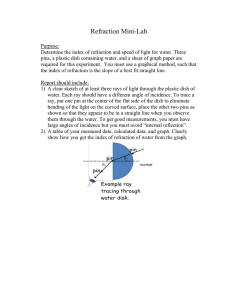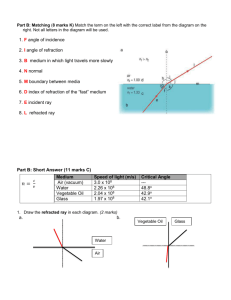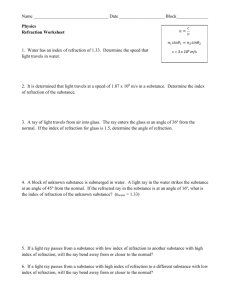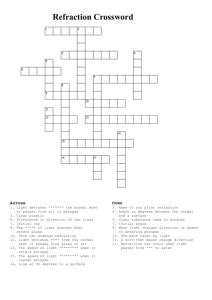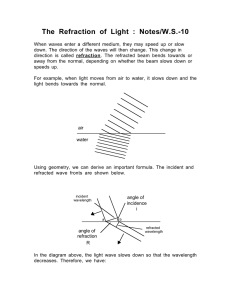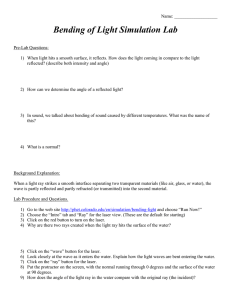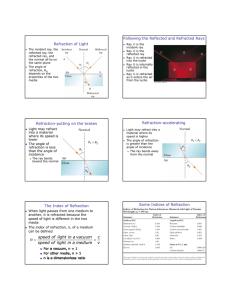Light The Electromagnetic Spectrum
advertisement
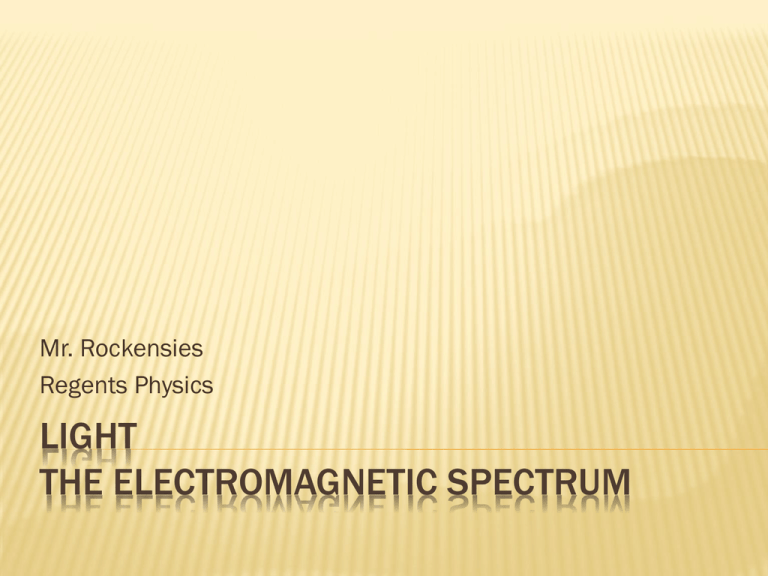
Mr. Rockensies Regents Physics LIGHT THE ELECTROMAGNETIC SPECTRUM COLORS OF LIGHT When light is seen as a single color, it is considered monochromatic When light has more than one color, it is referred to as polychromatic White light is the result of at least 3 colors, and usually is full-spectrum • Full spectrum means that it has all wavelengths of the electromagnetic spectrum. • Our Sun emits wavelengths across the entire spectrum. COHERENT LIGHT Coherent Light is monochromatic and all pulses are in phase Monochromatic Coherent REFRACTION Light is slower than c=3.00x108m/s in all media besides vacuum and air. The degree of bending depends on how much the light slows down. Index of Refraction = Speed of light in vacuum Speed of light in other medium n=c v Typical n values are on the reference tables SNELL’S LAW n1sinθ1 = n2sinθ2 θ1 = angle of incidence θ1 Medium 1 n1 Medium 2 n2 boundary θ2 θ2 = angle of reflection Waves bending in a Medium EFFECTS OF REFRACTION EXAMPLES OF REFRACTION b a slower medium c d d c In case “c” the refracted ray is right along the boundary – “critical” case. At this point, θ1 is called θc – the critical angle and θ2 is 90°. b θ2 = 90° a faster medium Find the n value FIBER OPTICS Based on laws of refraction, a fiber optic cable is designed so that any light that enters cannot leave until reaching an exit at the other end of the cable We call this phenomena “total internal reflection”, and it occurs when the incident angle is greater than the critical angle – resulting in a reflected ray. Fiber Optic Cable EFFECTS OF REFREACTION 1. Extended Sunset Ray from the Sun Earth Atmosphere Refracted Ray due to the atmosphere, allows us to see the Sun after it has set. EFFECTS OF REFRACTION 2. Dispersion of Colors • in non-dispersive media (vacuum & clean air) all colors have the same speed and bend the same amount •in dispersive media (everything else) each color has a slightly different speed and index of refraction •Red is the fastest, has the smallest index of refraction, and bends the least. DOPPLER EFFECT FOR LIGHT ( ( ( ( ( Receding Source, frequency appears lower (called “Red Shift”) • ) ) ) ) ) ) ) ) ) ) Approaching source, frequency moving source higher (called “Blue Shift”) REAL WORLD APPLICATIONS v 1. Radar Guns gun () ) () ) ( ) ) car reflected waves are shifted to red by receding object. By comparing the reflected waves to the original waves, the gun calculates the object’s speed 2. Doppler weather radar – same as radar gun ~ reflecting radio waves off of air masses/clouds. 3. Astronomy – stars are made of Hydrogen + Helium which have characteristic bright line spectra at known frequencies: Shifted lines indicate that a star is either approaching or receding from us When we observe light from other galaxies, all lines are red shifted – What would this imply? All galaxies are moving away from us – therefore the universe is expanding DIFFRACTION OF LIGHT We had said that when waves diffract they bend around corners: Light will exhibit this same behavior. As a result of this bending, we can see spaces of light and dark when light passes through two or more openings that are placed near each other. Young’s Double Slit Experiment If light passes through a boundary with two or more openings, we will see bands of light and dark appear on a surface beyond that barrier. POLARIZATION Because light is a transverse wave, it can become polarized. Light can also become polarized by reflecting off of a shiny surface – “glare” TIPS FOR THE REGENTS •Remember, if light passes from a faster medium into a slower medium (i.e. air into anything else), the refracted ray should be bent towards the normal. If light passes from a slow medium into a faster one (i.e. diamond into anything else) then the refracted ray should bend away from the normal. •When trying to find the critical angle, always remember that θ2 MUST be 90°, and therefore sin θ2 = 1. •You can find the velocity of light in ANY medium as long as you have its n value (index of refraction). Use n=c/v ! •When measuring the angle of incidence/refraction ALWAYS MEASURE FROM THE NORMAL!! •When a wave moves from one medium into another, its speed and WAVELENGTH change, not frequency (the color stays the same) •PRACTICE, PRACTICE, PRACTICE!!!


